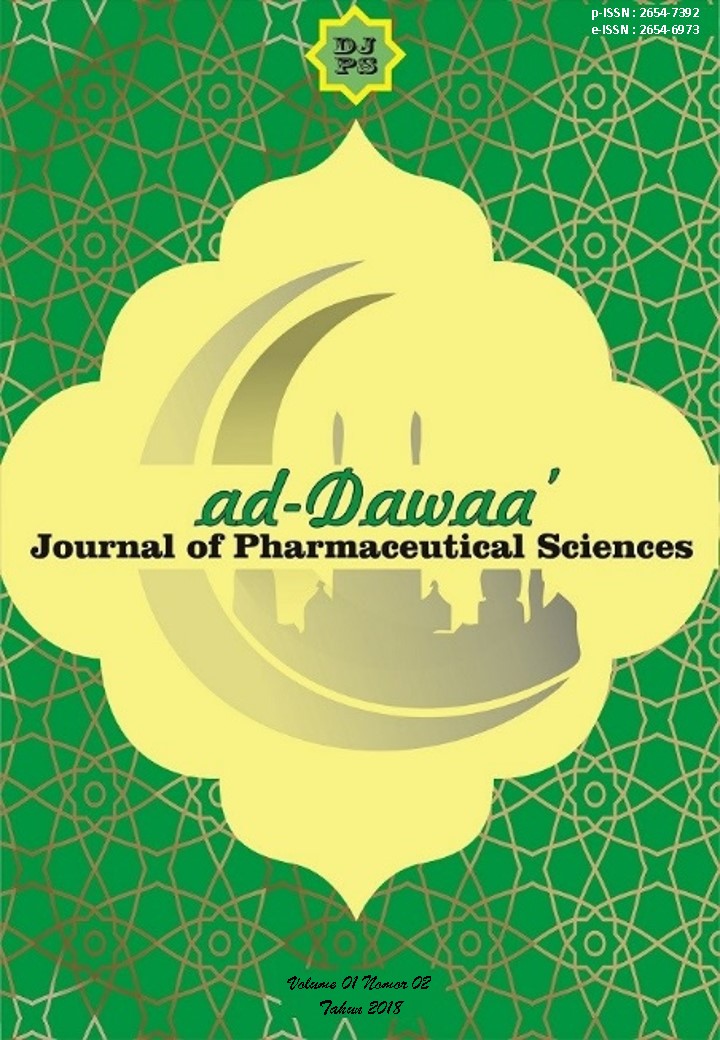Efek Ekstrak Metanol dan Partisi dari Kulit Batang Kayu Jawa (Lannea coromandelica Houtt. Merr.) terhadap Pertumbuhan Sel HeLa dan MCF-7
Abstract
Tujuan penelitian ini adalah menentukan efek ekstrak metanol dan partisi kulit batang kayu jawa dalam menghambat pertumbuhan sel kanker HeLa dan sel kanker MCF-7. Simplisia kulit kayu dimaserasi menggunakan pelarut metanol. Ekstrak kemudian dipartisi secara partisi cair padat menggunakan pelarut heksan. Pemisahan menghasilkan partisi larut heksan dan partisi tidak larut heksan. Pengukuran aktivitas inhibisi pertumbuhan sel dilakukan menggunakan metode MTT Assay terhadap sel HeLa, sel MCF-7 dan sel Vero. Senyawa yang dikandung diidentifikasi dengan beberapa pereaksi golongan. Hasil penelitian menunjukkan bahwa ekstrak metanol, partisi tidak larut heksan dan partisi larut heksan dapat menghambat pertumbuhan sel kanker Hela dengan nilai indeks selektivitas, berturut-turut, 2,04; 1,85 dam 4,19. Sedangkan untuk sel MCF-7, indeks selektivitas, berturut-turut, 1,91; 1,44 dan 2,13. Partisi larut heksan dapat memiliki potensi sebagai antikanker dengan selektivitas yang baik.
Downloads
References
American Cancer Society. (2015). Global Cancer Facts and Figure 3rd Section. Atlanta: American Cancer Society.
Chothiphirat, A., Nittayaboon, K., Kanokwiroon, K., Srisawat, T., &
Navakanitworakul, R. (2019). Anticancer Potential of Fruit Extracts fromVatica diospyroidesSymington Type SS and Their Effect on Program Cell Death of Cervical Cancer Cell Lines. The Scientific World Journal.
Czepas, J., & Gwozdzinski, K. (2014). The flavonoid quercetin: Possible solution for anthracyclines-induced cardiotoxicity and multidrug resistence. Biomedicine & Pharmacotheraphy, 1149-1159; Volume 68, Issue 8.
Dan Grander's Group. (2015).
Mechanisms of action of anti-cancer drugs. . Retrieved
April 16, 2017, from Oncology-Pathology Karolinska Institutet: file:///C:/Users/Microssoft/Downloads/SK RIPSI%20ZAKIAH/mechanisms-ofaction-of-anti-cancer-drugs.htm
Islam, M. T., & Tahara, S. (2000). Dihydroflavonols from Lannea
coromandelica. Phytochemistry, 54(8), 901-907. Kementrian Kesehatan. (2015). Pusat Data dan Informasi Kanker. Jakarta.
Kumler, I., Stenvang, J., Moreira, J., Brunner, N., & Nielsen, D. L. (2015). Drug transporters in breast cancer: responses to anthracyclines and taxanes. Expert Review of Anticancer Theraphy, 1075-1092; Volume 15, Issue 9.
Luca, A. D., D'Alessio, A., Maiello, M. R., Gallo, M., Chicchinelli, N., Pergameno, M., . . . Normanno, N. (2015). Evaluation of the pharmacokinetics of Ixabepilone for the treatment of breast cancer. Expert Opinion on Drug Metabolism & Toxicology, 1177-1185; Volume 11, Issue
Nugroho, A. E. (2014). Farmakologi. Yogyakarta: Pustaka Pelajar.
Reddy, A. K., Joy, J. M., & Kumar, C. A. (2011). Lannea coromandelica: The Researcher’s Tree. Avinash Kumar Reddy et al./Journal of Pharmacy Research, 577-579.
Siegel, R. L., Miller, K. D., & Jemal, A. (2017). Cancer Statistics. CA: A Cancer Journal for Clinicans, 7-30; Volume 67, Issue 1.
Sivaraj, C., Pavithra, B., Srivastav, A., & Arumugam, P. (2018). GC-MS Analysis, Antibacterial and Anticancer Activities of Bark Extract of Lannea coromandelica (Houtt.) Merr. International Journal Of Pharmaceutical Sciences And Research, 3047-3051.
Subramanian, S. S., & Nair, A. G. (1971). Polyphenols of Lannea coromandelica. Phytochemistry, 10(8), 1939-1940.
Tia, L. J., Lui, A. G., Chua, N. S., & Strebel, H. M. (2015). Chemotheraphy-induced neutropenia, anemia and thrombocytopenia, among Filipino breast
cancer patients on adjuvant chemotehraphy. Original Article, 26; Volume 49 No.2.
Once an article was published in the journal, the author(s) are:
- granted to the journal right licensed under Creative Commons License Attribution that allows others to share the work with an acknowledgement of the work's authorship.
- permitted to publish their work online in third parties as it can lead to wider dissemination of the work.
- continue to be the copyright owner and allow the journal to publish the article with the CC BY-SA license
- receiving a DOI (Digital Object Identifier) of the work.


1.png)